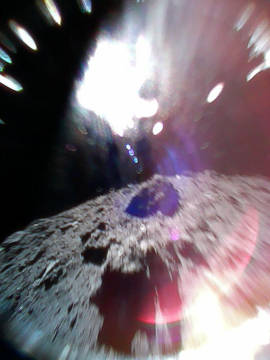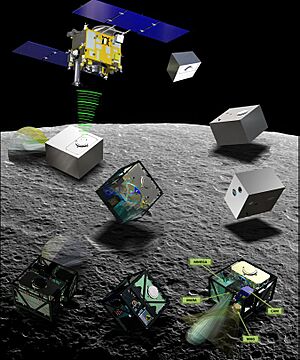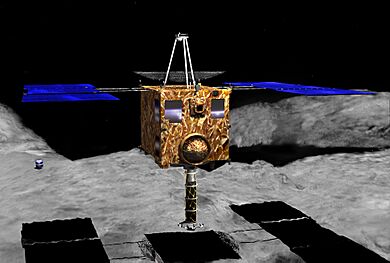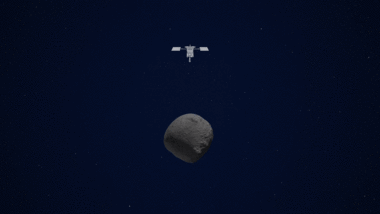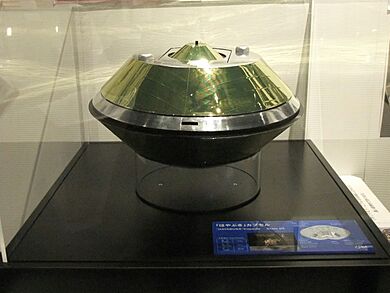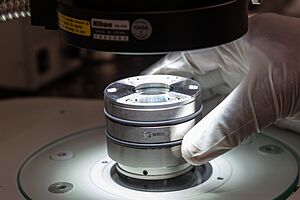Hayabusa2 facts for kids
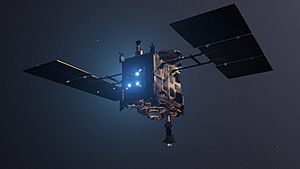
Artist's impression of Hayabusa2 firing its ion thrusters
|
|
| Mission type | Asteroid sample-return |
|---|---|
| Operator | JAXA |
| Mission duration | 6 years (planned) (11 years and 17 days elapsed) |
| Spacecraft properties | |
| Spacecraft type | Hayabusa |
| Manufacturer | NEC |
| Launch mass | 600 kg |
| Dry mass | 490 kg (1,080 lb) |
| Dimensions | Spacecraft bus: 1 × 1.6 × 1.25 m (3 ft 3 in × 5 ft 3 in × 4 ft 1 in) Solar panel: 6 m × 4.23 m (19.7 ft × 13.9 ft) |
| Power | 2.6 kW (at 1 au), 1.4 kW (at 1.4 au) |
| Start of mission | |
| Launch date | 3 December 2014, 04:22:04 UTC |
| Rocket | H-IIA 202 |
| Launch site | Tanegashima Space Center, LA-Y |
| Contractor | Mitsubishi Heavy Industries |
| End of mission | |
| Landing date | Re-entry capsule: 5 December 2020 UTC |
| Landing site | Woomera, Australia |
| Flyby of Earth | |
| Closest approach | 3 December 2015 |
| Distance | 3,090 km (1,920 mi) |
| Invalid value for parameter "type" | |
| Invalid parameter | 27 June 2018, 09:35 UTC |
| "departure_date" should not be set for missions of this nature | 12 November 2019 |
| Sample mass | 5.4 grams(including gas samples) |
| (162173) Ryugu lander | |
| Landing date | 21 February 2019 |
| (162173) Ryugu lander | |
| Landing date | 11 July 2019 |
| Flyby of Earth (Sample return) | |
| Closest approach | 5 December 2020 UTC |
Hayabusa2 (Japanese: はやぶさ2, lit. Peregrine falcon 2) is a special space mission from Japan's space agency, JAXA. Its main goal was to collect tiny pieces of an asteroid and bring them back to Earth. This mission followed the first Hayabusa spacecraft, which was the first to ever bring asteroid samples home in 2010.
Hayabusa2 launched on December 3, 2014. It traveled through space and met up with a near-Earth asteroid called 162173 Ryugu on June 27, 2018. The spacecraft spent about a year and a half studying the asteroid and gathering samples. It left Ryugu in November 2019 and successfully delivered the samples to Earth on December 5, 2020. The mission is now continuing until at least 2031, with plans to visit another small, fast-spinning asteroid called 1998 KY26.
Hayabusa2 carried many tools for looking at the asteroid from far away and for collecting samples. It also had four small robots, called rovers, to explore the asteroid's surface. These rovers helped scientists understand the asteroid's environment and geology where the samples were taken.
Contents
Why Explore Asteroids?
Asteroid 162173 Ryugu is a type of asteroid known as a carbonaceous near-Earth asteroid. Scientists believe these asteroids hold some of the oldest and most untouched materials from the early Solar System. These materials are a mix of minerals, ice, and special chemicals called organic compounds.
Studying Ryugu can teach us a lot about how the inner planets, like Earth, were formed. It can also help us understand where water and organic compounds on Earth came from. This knowledge is important for figuring out how life first began on our planet.
Hayabusa2's Journey to Ryugu
Hayabusa2 was launched on December 3, 2014, using a H-IIA rocket. It arrived at Ryugu on June 27, 2018. For about a year and a half, it carefully studied the asteroid and collected its precious samples. The spacecraft then began its journey back to Earth in November 2019. It returned the samples to Earth in December 2020, dropping them by parachute in Australia.
Compared to the first Hayabusa mission, Hayabusa2 had many improvements. It had better ion engines, smarter navigation systems, and improved antennas. It even carried a special device to shoot a small explosive into the asteroid. This created a fresh crater, allowing the spacecraft to collect material from beneath the surface.
How Hayabusa2 Was Built
The Hayabusa2 spacecraft was designed based on the first Hayabusa mission, but with important upgrades. It weighed about 600 kilograms (1,300 lb) with its fuel. Its power came from two large solar arrays. These panels could generate enough electricity to power the spacecraft.
Powering Through Space
The spacecraft uses four special ion thrusters for propulsion. These engines are called μ10. They work by using microwaves to turn xenon gas into a super-hot gas called plasma. This plasma is then pushed out the back of the engine, creating a tiny but constant push. Even though the push is small, these engines are very efficient. The 66 kg (146 lb) of xenon fuel allowed the spacecraft to change its speed by a huge amount, up to 2 km/s.
Hayabusa2 also has smaller chemical thrusters. These are used for fine-tuning its position and for controlling its orientation (which way it's pointing) when it's near the asteroid.
Talking to Earth
The main company that built Hayabusa2 was NEC. They also created its communication system and a special camera that sees heat. The spacecraft has two large antennas to send and receive signals from Earth. These signals travel at different radio frequencies, like X-band and Ka-band. Ground stations in Japan, the NASA Deep Space Network, and the ESA's Malargüe Station helped communicate with the spacecraft.
Finding Its Way
To navigate through space and around the asteroid, Hayabusa2 used several cameras. The Optical Navigation Camera (ONC-T) is like a telescope camera that sees in seven different colors. It worked with other wide-angle cameras and star trackers to know where the spacecraft was going.
When it needed to land on the asteroid to collect samples, the spacecraft dropped special reflective markers. These markers acted like targets, helping the spacecraft guide itself down. It also used a laser tool called LIDAR to measure its distance from the asteroid's surface.
Amazing Firsts for Hayabusa2
The Hayabusa2 mission achieved some incredible milestones:
- It was the first spacecraft to successfully deploy working rovers onto an asteroid's surface.
- It was the first mission to collect samples from beneath an asteroid's surface.
Science Tools on Board
Hayabusa2 carried many scientific tools to help it study Ryugu:
- Remote Sensing Tools: These cameras and sensors looked at the asteroid from a distance. They included different types of cameras (ONC-T, ONC-W1, ONC-W2), a Near-Infrared Camera (NIR3), a Thermal-Infrared Camera (TIR), and a Light Detection And Ranging (LIDAR) tool.
- Sampling Tools: These were used to collect pieces of the asteroid. They included the main sampling device (SMP), a Small Carry-on Impactor (SCI), and a Deployable Camera (DCAM3).
- Four Rovers: These small robots explored the asteroid's surface up close. They were called MASCOT, Rover-1A, Rover-1B, and Rover-2.
Exploring with Rovers
Hayabusa2 carried four small rovers to explore the asteroid's surface. Because Ryugu has very little gravity, these rovers didn't use wheels. Instead, they moved around by making short hops! They were dropped from about 60 m (200 ft) above the asteroid and gently fell to the surface.
The first two rovers, called HIBOU (Rover-1A) and OWL (Rover-1B), landed on Ryugu on September 21, 2018. They worked well and sent back data. The third rover, MASCOT, landed successfully on October 3, 2018, and worked for about 16 hours. The fourth rover, Rover-2, had problems before it was released. It was still released to orbit the asteroid and gather information about its gravity before crashing onto the surface.
MINERVA-II Rovers
The MINERVA-II system included two containers with three rovers.
- MINERVA-II-1 deployed two rovers, HIBOU (Rover-1A) and OWL (Rover-1B), on September 21, 2018. These rovers were shaped like cylinders, about 18 cm (7.1 in) wide and 7 cm (2.8 in) tall. They weighed about 1.1 kg (2.4 lb) each. They moved by hopping, using spinning weights inside them to create a push. They had cameras and thermometers. Both rovers worked well, sending back images and videos from the asteroid's surface. HIBOU worked for 36 Earth days, sending 609 images. OWL worked for 3 Earth days, sending 39 images.
- The ROVER-2 (MINERVA-II-2) was shaped like an octagon, about 15 cm (5.9 in) wide and 16 cm (6.3 in) tall, weighing about 1 kg (2.2 lb). It had cameras, a thermometer, and a sensor to measure movement. It also had lights to look for dust particles. Even though it had problems, it was released on October 2, 2019, to orbit the asteroid and measure its gravity before crashing on October 8, 2019.
MASCOT Rover
The Mobile Asteroid Surface Scout (MASCOT) was built by German and French space agencies. It measured about 29.5 cm × 27.5 cm × 19.5 cm (11.6 in × 10.8 in × 7.7 in) and weighed 9.6 kg (21 lb). MASCOT carried four tools: a special camera, a device to measure heat, a magnet sensor, and a camera to take detailed pictures of the surface. This rover could flip itself over to get into new positions for more measurements. It collected data on the asteroid's surface, its minerals, how it behaves with heat, and its magnetic properties. MASCOT ran on a battery for about 16 hours.
MASCOT landed successfully on October 3, 2018, and completed its mission. Scientists learned that C-type asteroids like Ryugu are more porous (like a sponge) than they thought. This helps explain why we don't find many meteorites of this type on Earth – they are too fragile to survive entering our atmosphere. They also found that Ryugu has two types of dark rock with little internal strength, but no dust.
How Samples Were Collected
The original plan was for Hayabusa2 to collect three types of samples:
- Material from the surface that showed signs of water-rich minerals.
- Surface material with little or no signs of water changes.
- Material from deep under the surface.
The first surface sample collection was planned for late 2018. However, the rovers found that the asteroid's surface was covered in large and small rocks, with not enough smooth soil for easy sampling. So, the team decided to wait until 2019.
First Surface Sample
The first sample from the asteroid's surface was collected on February 21, 2019. The spacecraft slowly moved closer to the asteroid. When a special horn on its underside touched the surface, a small 5 g (0.18 oz) metal bullet was fired into the asteroid at 300 m/s (980 ft/s). The tiny pieces of asteroid that flew up were then caught by a special collector at the top of the horn.
Sub-Surface Sample
To get a sample from under the surface, Hayabusa2 needed to create a crater. This would expose material that hadn't been changed by space weather. On April 5, 2019, Hayabusa2 released a special device called the Small Carry-on Impactor (SCI). This device was like a small gun with a 2.5 kg (5.5 lb) copper bullet. It used an explosive charge to shoot the bullet into the asteroid.
After releasing the SCI, Hayabusa2 also left behind a camera (DCAM3) to watch the impact. The main spacecraft then moved to the other side of the asteroid to avoid being hit by flying debris.
About 40 minutes after the SCI was released, it fired its copper bullet into the asteroid from about 500 m (1,600 ft) away. This created a crater about 10 m (33 ft) wide, digging up fresh material. On June 4, 2019, a reflective target marker was dropped near the new crater to help with navigation. The final touchdown and sub-surface sampling happened on July 11, 2019.
Bringing Samples Home
The samples collected by Hayabusa2 were stored in special sealed containers inside a sample return capsule (SRC). This capsule was designed to protect the samples from heat and other dangers. It was about 40 cm (16 in) wide, 20 cm (7.9 in) tall, and weighed about 16 kg (35 lb).
In November 2019, after finishing its work at Ryugu, Hayabusa2 used its ion engines to start its journey back to Earth. Hours before flying past Earth, on December 5, 2020, it released the sample capsule. The capsule spun as it was released. It then entered Earth's atmosphere at a speed of 12 km/s (7.5 mi/s). At about 10 km (6.2 mi) altitude, it deployed a parachute and dropped its heat shield. The capsule landed safely in the Woomera Test Range in Australia. The total distance traveled by the mission was an incredible 5.24×109 km (35.0 AU).
Scientists will carefully open the sealed containers to collect any gases or other delicate substances first. The samples will be studied at JAXA's Extraterrestrial Sample Curation Center in Japan. Scientists from around the world can ask to study small parts of these samples. The capsule brought back asteroid pieces rich in carbon. Scientists believe these pieces could help explain how water and organic molecules (important for life) arrived on Earth long ago.
JAXA is sharing some of these samples with NASA. In return, NASA will share samples from asteroid Bennu, which its OSIRIS-REx spacecraft brought back to Earth in 2023.
What's Next for Hayabusa2?
With the samples safely back on Earth, Hayabusa2 is not done yet! It still has about 30 kg (66 lb) of xenon fuel left. JAXA decided to extend its mission to explore new targets. This extended mission is called “Hayabusa2♯” (read as “Hayabusa2 Sharp”). The "♯" symbol is a musical note that means "raise the note," showing that this mission is taking on even harder challenges. It also stands for "Small Hazardous Asteroid Reconnaissance Probe," meaning it will study small asteroids that could be dangerous if they hit Earth.
Here's the plan for the extended mission:
- December 2020: Extended mission begins.
- 2021 to July 2026: The spacecraft travels through space.
- July 2026: It will fly by a rare type of asteroid called 2001 CC21 at high speed.
- December 2027: It will use Earth's gravity to help it change direction (Earth swing-by).
- June 2028: Another Earth swing-by.
- July 2031: It will meet up with its new target, a very fast-spinning tiny asteroid called 1998 KY26. This will be the first time a spacecraft visits such a fast-rotating micro-asteroid.
Between 2021 and 2026, the spacecraft will also look for exoplanets (planets outside our solar system).
See also
 In Spanish: Hayabusa 2 para niños
In Spanish: Hayabusa 2 para niños
- Abiogenesis
- Hayabusa Mk2
- OSIRIS-REx – NASA's mission to bring samples from asteroid 101955 Bennu (happened at the same time as Hayabusa2)
- Panspermia
Images for kids



